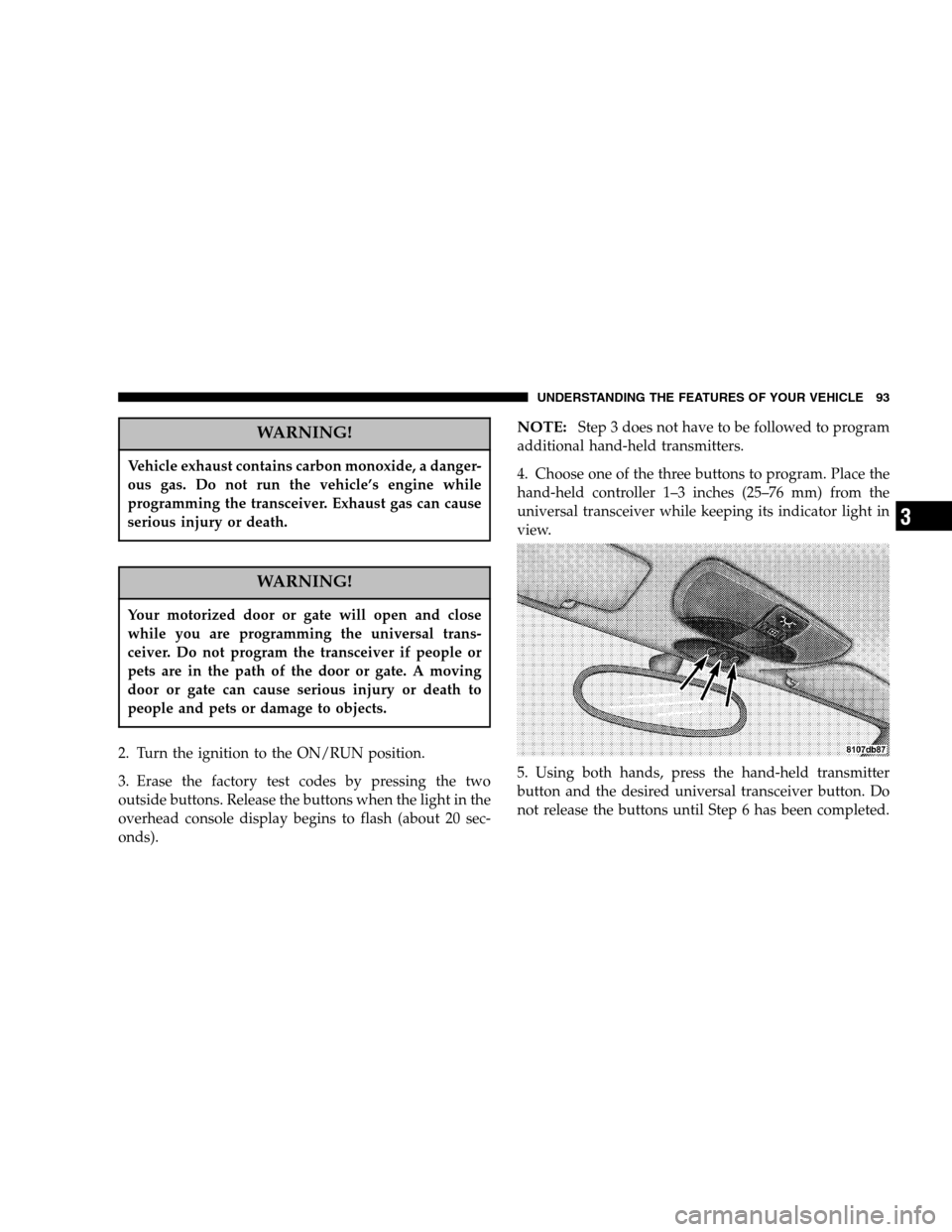display CHRYSLER CROSSFIRE 2005 1.G Owners Manual
[x] Cancel search | Manufacturer: CHRYSLER, Model Year: 2005, Model line: CROSSFIRE, Model: CHRYSLER CROSSFIRE 2005 1.GPages: 288, PDF Size: 24.37 MB
Page 10 of 288

Obtaining Replacement Keys
Your vehicle is equipped with a theft deterrent locking
system requiring a special key manufacturing process.
For security reasons, replacement keys can only be ob-
tained from your authorized dealer.
Important!
Removing the key from the steering lock activates the
start lock-out. The engine cannot be started.
Turning the key in the steering lock to the ON/RUN
position deactivates the start lock-out.
NOTE:In case the engine cannot be started, and START
and ERROR are shown in the odometer display field, the
system is not operational. Contact an authorized dealer.
Ignition Key Removal
Turn the key to the LOCK position and remove the key.
NOTE:For vehicles with automatic transmissions, if
you try to remove the key before you place the shift lever
in PARK, the key may become trapped temporarily in the
key cylinder. If this occurs, turn the key clockwise
slightly, then remove the key as described.
Key-In-Ignition Reminder
Opening the driver’s door when the key is in the ignition
sounds a signal to remind you to remove the key.
10 THINGS TO KNOW BEFORE STARTING YOUR VEHICLE
Page 14 of 288

Perform the quick system check which follows: Use
the remote transmitter to set the alarm. If the parking
lamps flash three times, the system is operating prop-
erly. If not, there is a problem with a switch or the
system. See your authorized dealer for service.
Emergency Unlocking Feature
In the case of an accident, the doors unlock automatically
a short time after a strong deceleration is detected, such
as in a collision (this is intended to aid rescue and exit).
However, the key must still be in the ignition.
Start Lockout
Removing the key from the ignition switch activates the
start lockout. The engine cannot be started. Turning the
key to the ON/RUN position deactivates the start lock-
out. If the engine cannot be started, and the messages
START and ERROR are shown in the odometer display
field, the system is not operational. Contact an autho-
rized dealer.
REMOTE KEYLESS ENTRY
This feature allows you to lock or unlock the vehicle from
remote locations using a hand-held transmitter located in
the key fob. You don’t have to point the transmitter at the
vehicle to activate the system. The vehicle doors, rear
liftgate/decklid, fuel filler door, and center console (road-
ster only) can be locked and unlocked using the remote
control.
To Unlock the Doors:
Press and release the unlock button on the key fob.
NOTE:If within 40 seconds of unlocking with the key
fob, neither door is opened, the key is not inserted in the
ignition switch, or the central locking switch is not
activated, the vehicle will automatically lock.
Press the Unlock transmit button on the key fob once to
unlock driver’s door, rear liftgate/decklid, fuel filler
door, and center console (roadster only). Press the Unlock
transmit button twice to unlock both doors, rear liftgate/
decklid, fuel filler door, and center console (roadster
only).
14 THINGS TO KNOW BEFORE STARTING YOUR VEHICLE
Page 93 of 288

WARNING!
Vehicle exhaust contains carbon monoxide, a danger-
ous gas. Do not run the vehicle’s engine while
programming the transceiver. Exhaust gas can cause
serious injury or death.
WARNING!
Your motorized door or gate will open and close
while you are programming the universal trans-
ceiver. Do not program the transceiver if people or
pets are in the path of the door or gate. A moving
door or gate can cause serious injury or death to
people and pets or damage to objects.
2. Turn the ignition to the ON/RUN position.
3. Erase the factory test codes by pressing the two
outside buttons. Release the buttons when the light in the
overhead console display begins to flash (about 20 sec-
onds).
NOTE:Step 3 does not have to be followed to program
additional hand-held transmitters.
4. Choose one of the three buttons to program. Place the
hand-held controller 1–3 inches (25–76 mm) from the
universal transceiver while keeping its indicator light in
view.
5. Using both hands, press the hand-held transmitter
button and the desired universal transceiver button. Do
not release the buttons until Step 6 has been completed.
UNDERSTANDING THE FEATURES OF YOUR VEHICLE 93
3
Page 99 of 288

INSTRUMENT CLUSTER
The instrument cluster displays are activated by either
opening the door, pressing the left button within the
cluster, or turning the key in the ignition switch to the
ON/RUN position.
INSTRUMENT CLUSTER DESCRIPTION
1. Low Windshield Washer System Fluid Level
Warning Light
With the key in the ignition switch turned to
the ON/RUN position, the indicator light
comes on. It should go out when the engine
is running.
If the indicator light does not go out after starting the
engine, or if it comes on while driving, the fluid reservoir
is less than
1�4filled.
The reservoir should be refilled at the next opportunity
with commercially available premixed windshield
washer solvent/antifreeze or water, depending on ambi-
ent temperature.
The reservoir for the windshield washer system is located
in the engine compartment and the cap is marked with
the above symbol.
UNDERSTANDING YOUR INSTRUMENT PANEL 99
4
Page 105 of 288

If the charging system indicator light comes on, or a loss
of power steering assistance is noticeable while the
engine is running, this may indicate that the accessory
drive belt has broken. Should this condition occur, the
belt must be replaced before continuing to operate the
vehicle.
CAUTION!
The accessory drive belt also drives the water pump.
Operating the vehicle with a failed belt can cause
engine overheating and possible severe engine dam-
age.
16. High Beam Indicator Light
This indicator will illuminate when the
headlights are in the high beam setting.
To activate the high beams, push the multifunction
control lever past the point of resistance, toward the
instrument panel.
17. Electronic Digital Clock
A digital readout in the instrument cluster shows the
time in hours and minutes whenever the ignition switch
is in the ON/RUN or ACC position.
When the ignition switch is in the OFF/LOCK position,
timekeeping is accurately maintained.
The display can be adjusted with the knob/button lo-
cated to the left of the clock.
18. Gear Indicator
For automatic transmission vehicles, the current gear
shift selector range is indicated in the gear range indica-
tor display.
19. Push Button for Time Setting
To adjust the time display, turn the key in the ignition
switch to the ON/RUN or ACC position. The knob/
button located just to the left of the clock is used to
change the time. Pull out the knob and turn it to the left
for hour adjustment; pull out the knob and turn it to the
right for minute adjustment.
UNDERSTANDING YOUR INSTRUMENT PANEL 105
4
Page 106 of 288

20. Trip Odometer, Flexible Service System (FSS)
Indicator
This display shows the distance traveled since last reset.
To reset:
•Press the button to the left of the display once (with
the key in the ON/RUN position).
•Press the button twice (with the key removed or in
the OFF/LOCK or ACC position).
21. Main Odometer, Flexible Service System (FSS)
This shows the total distance the vehicle has been driven.
U.S. Federal regulations require that upon transfer of
vehicle ownership, the seller certify to the purchaser the
correct distance that the vehicle has been driven. There-
fore, if the odometer reading is changed during repair or
replacement be sure to keep a record of the reading
before and after service so that the correct distance can be
determined.
22. Push Button for Activating the Instrument
Cluster, Intensity of Instrument Lights, for Resetting
Trip Odometer and Flexible Service System (FSS)
Indicator
Press the knob/button to illuminate the display. To vary
the intensity of the instrument cluster lights, rotate the
knob/button.
To reset the trip odometer, press the knob/button once
with the key in the ON/RUN position. Press the knob/
button twice with the key removed or in the OFF/LOCK
or ACC position.
The FSS permits a flexible service schedule that is directly
related to the operating conditions of the vehicle.
There are two symbols which will appear in the
main odometer display field prior to the next
suggested service. This symbol represents Ser-
vice A.
This second symbol represents Service B.
106 UNDERSTANDING YOUR INSTRUMENT PANEL
Page 107 of 288

Depending on operating conditions through-
out the year, the next service is calculated and
displayed next to this symbol in days remain-
ing before the next service is required.
Likewise, the next service may be calculated
and displayed next to this symbol as distance
remaining before the next service is required.
The counter can also be reset by any individual after the
indicated service has been performed. To do so:
1. Turn key to the ON/RUN position.
2. Within one second press the knob/button twice.
3. The present status for days or distance is dis-
played. Within 10 seconds turn the key to OFF/
LOCK.
4. Press and hold the knob/button, while turning
the key to ON/RUN again. The present status for
days or distance is displayed once more. Continue
to hold the knob/button.
After approximately 10 seconds, a signal sounds and
the display shows 7,000 miles (Canada: 11,000 km) for
approximately 10 seconds.
5. Release the knob/button.
If the FSS counter was inadvertently reset, have an
authorized dealer correct it.
The message is displayed for approximately 10 sec-
onds when turning the key to the ON/RUN position,
or while driving when reaching the service warning
threshold. It can be canceled manually by pressing the
knob/button.
Once the suggested term has passed, the message plus
either the symbol for Service A or the symbol for
Service B preceded by a – (minus symbol) blinks for
approximately 30 seconds and a signal sounds every
time when turning the key to the ON/RUN position.
The FSS display can also be called up for approxi-
mately 10 seconds with the display illuminated by
pressing the knob/button twice within one second.
UNDERSTANDING YOUR INSTRUMENT PANEL 107
4
Page 108 of 288

Following a completed A or B service your authorized
dealer sets the counter to 7,000 miles (Canada: 11,000
km).
NOTE:When disconnecting vehicle battery for one or
more days at a time, such days will not be counted. Any
such days not counted by FSS can be added by your
authorized dealer.
The interval between services is determined by the type
of vehicle operation. Driving at extreme speeds, and cold
starts combined with short distance driving in which the
engine does not reach normal operating temperature,
reduce the interval between services.
However you choose to set your reference numbers, the
scheduled services as posted in the Service Booklet must
be followed to properly care for your vehicle.
23. Outside Temperature Display
The temperature display is located on the left side of the
instrument cluster, below the fuel and engine tempera-
ture gauges.The sensor for the outside temperature indicator is
located in the front fascia area. Due to its location, the
sensor can be affected by road or engine heat during
idling or slow driving. This means that the accuracy of
the displayed temperature can only be verified by com-
parison to a thermometer placed next to the sensor, not
by comparison to external displays (e.g., bank signs, etc.).
Adaptation to ambient temperature takes place in steps
and depends on the prevailing driving conditions (stop-
and- go or moderate, constant driving) and amount of
temperature change.
WARNING!
The outside temperature indicator is not designed to
serve as an ice-warning device and is unsuitable for
that purpose. Indicated temperatures just above the
freezing point do not guarantee that the road surface
is free of ice.
108 UNDERSTANDING YOUR INSTRUMENT PANEL
Page 111 of 288

CHECKING ENGINE OIL LEVEL
A sensor in the oil pan allows oil level to be checked
without opening the hood. It provides an accurate mea-
surement of oil level, whereas the low engine oil level
indicator warns that oil level is definitely too low. With
the vehicle parked on a level surface, the engine is
warmed up and shut off for approximately five minutes.
When the ignition switch is turned to the ON/RUN
position, an ISO oil level icon appears in the trip odom-
eter window and a “clock” icon in the cumulative
odometer display. Pressing the knob to the left of the
speedometer twice within one second displays one of the
following messages:
•OK
•-1.0 Q (-1.0L)
•-1.5 Q (-1.5L)
•-2.0 Q (-2.0L)
•HIThe indicated amount of oil must be added to the engine
if the message -2.0 Q (-2.0L) blinks and a signal sounds.
The HI message indicates that the excess oil must be
removed from the pan to avoid possible engine or
catalytic converter damage. If the ISO oil level icon and
“clock” icon remain on when attempting to check oil
level and no message follows, or if the low engine oil
level warning lamp comes on, a malfunction in the
engine oil level system is indicated. A conveniently
located dipstick allows manual checking of the oil level.
If no leaks are noted, continue to drive to the nearest
service station where the engine oil should be topped to
the “full” mark on the dipstick with an approved oil.
29. Low Fuel Warning Light
When the fuel level drops to about 2 gallons (7.5
liters), this symbol will light and remains lit until
fuel is added.
UNDERSTANDING YOUR INSTRUMENT PANEL 111
4
Page 114 of 288

FM AS – An autostore feature will store the 9 current
stations with the strongest signal on station buttons 1-9 in
the order of their signal quality.
Press the FM button repeatedly until FM AS is displayed
to perform an autostore scan. Press the multifunction
button labeled AS repeatedly until AS-SEEK is displayed.
To select the stored stations, press the 1-9 buttons.
BEST FM – The BEST FM function automatically memo-
rizes and continuously updates the frequencies of sta-
tions in order of their signal strength.
The strongest station comes up first when BEST FM is
selected. Stations with stronger or weaker signals are
selected by turning the right rotary knob.
To select the displayed station, press the right rotary
control/push button.
Tuning FM stations – Rotating the right rotary control to
the right or left will change the FM frequency to the next
higher or lower station with a strong signal. To manually
step through each frequency or tune in a station with a
weaker signal, press the MAN button first, and then
rotate the rotary control right or left.Storing FM stations – 10 frequencies can be stored on FM
1 and on FM 2 by pressing a multifunction button for
three seconds; a tone will confirm that the selection was
set.
Scan Search FM (SC) – To activate, press the right rotary
control/push button until SC is displayed.
Beginning with the currently set frequency, the next
station scanned will be heard for eight seconds. Press the
right rotary control/push button if you wish to keep the
current station. Once the scan begins, it will continue
until either a station or program is retained or until
another mode is selected.
Radio Data System (RDS) Stations
PTY (Program Type)
The program type of the selected station can be displayed
for 10 seconds, or scanned in order of ascending fre-
quency for eight seconds each.
To activate, press the OPT button in FM mode, then press
the multifunction PT button. You can pre-select one of the
114 UNDERSTANDING YOUR INSTRUMENT PANEL